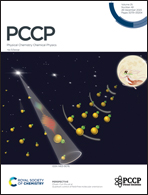Ab initio study for late steps of CO2 and CO electroreduction: from CHCO* toward C2 products on Cu and CuZn nanoclusters†
Abstract
Electroreduction of CO2 to C2 products such as ethanol is motivated by its potential application to satisfy global energy demand in a more sustainable and renewable way. Cooper-based catalysts have exhibited highlighted performance in obtaining C2 products, but large overpotentials and poor selectivity are still challenging. Herein, we employed density functional theory calculations and the computational hydrogen electrode model to study the impact of CuZn alloys on the mechanism and selectivity of CO2 and CO electroreduction to C2 products. On both clusters, the preferred pathway to ethanol and ethylene shares a common intermediate: CH2CHO*. On Cu55, ethanol formation would occur at lower electrode potential than the formation of ethylene, which agrees with experimental studies. Since Cu42Zn13 increases the Gibbs free energy change between CH2CHO* and adsorbed acetaldehyde, the alloy exhibited lower selectivity toward ethanol than Cu55 cluster. The role of Zn is mainly related to the stronger adsorption of the intermediates on Cu42Zn13 than in the Cu55 group. Our results suggested that the d states of Zn are involved in the adsorption of intermediates, strengthening the interaction.



 Please wait while we load your content...
Please wait while we load your content...